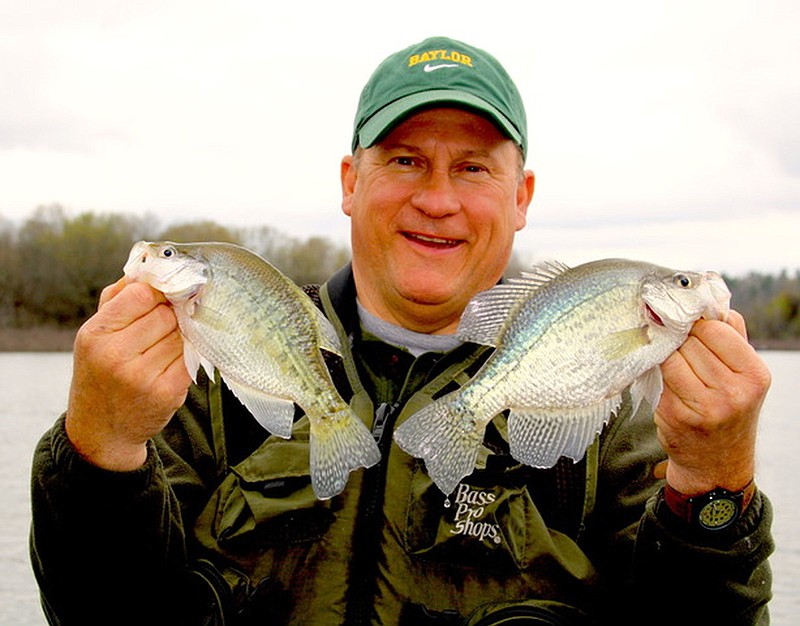Crappie are on the banks, and there's no better time to catch them than right now.
No matter where you are in Arkansas, crappie are spawning in shallow water. You don't need fancy electronics to find them in deep brush piles. You only need to work the bank with your favorite crappie baits to find enough for a good fish fry or two.
Generally speaking, the peak of the crappie spawn coincides with the NCAA championship basketball tournaments and spring break. Bill Eldridge and Kelly Eldridge of Benton always take a little time off to camp on Lake Ouachita and get in some quality fishing time and cheer on their beloved Baylor basketball teams.
Eldridge, a brush-pile specialist, said when crappie go to the banks, the fishing is easy. He works the banks methodically with minnows and light jigs tipped with tiny, paddletail swimbaits and plastic tubes. He also sets out a milk run of yo-yos baited with live minnows. These are good for catching crappie at night, but crappie often hit them in daylight, too, requiring twice-daily checks.
Shawn Paul Miller of Jessieville is a young man who is loyal to old-school tactics. His boat is an old aluminum flat bottom with a tiny outboard motor.
"The only electronics I have is a trolling motor," Miller said. "I can't afford $3,500 for a LiveScope or anything like that."
Miller uses inexpensive bass fishing tackle, notably a Berkley Lightning Rod and an Abu Garcia spinning rod spooled with 6-pound test line. Light line allows Miller's 1/32-ounce jig to sink.
"I don't use anything bigger because it really don't sink right," Miller said. "The bigger line brings your grub back to the top of the water when you need it to stay deep. Lately, that's about five to six feet."
For jig color, Miller likes white or unpainted. He uses a 2-inch Kalin's grub. In clear water, he prefers Arkansas shiner or Tennessee shad. For stained water, he prefers dark colors, like black/blue/chartreuse or Hot Mama (red/pink/chart).
"If I see brush, I slow-roll it right over the top of it and reel it as slow as I possibly can," Miller said. "I've got to keep the tail a'wigglin' or I'm not going to do any good. It's got to have some action. I also look for treetops, weed lines or any kind of trees that have fallen off in water as long as they still have branches. It's all got crappie on it right now. That's pretty much all you've got to do."
If your favorite lake is high, the water will be in the buck brush along the shoreline. Miller said crappie are hovering at the outside edges of the brush.
"I stayed at the Highway 27 Fishing Village at Lake Ouachita last week," Miller said. "I averaged 10 to 20 crappie a day. That's not a lot, but they were all a pound-and-a-quarter to pound-and-a-half fish, with a couple of 2-pounders."
Miller said he didn't know where to start, so he began his day bass fishing with a white spinnerbait. His first bite was a 2-pound crappie.
"I swapped out to the Kalin's grub and ended up with eleven," Miller said. "They were all nice fish. It can happen just like that. If you catch one bass fishing, you'd better shut down and fish a grub."
My favorite technique is similar to Miller's. I fish the tops of downed trees lying in the water. The most productive locations are in deep coves or even deep bank-side notches. The bottom often contains gravel for spawning beds. Fishing with a partner, I use an anchor on the bow and stern to hold the boat perpendicular to the cover so both of us can reach the cover. If I'm alone, only the bow faces the cover.
I use a long crappie rod with 8-pound test backing and an 18-inch, 4- to 6-pound-test fluorocarbon leader. A 1/32 ounce or 1/64-ounce marabou jig is the right weight to fall slowly into the strike zone. If the water is 5-6 feet deep, I want the jig no deeper that 2-3 feet because crappie look upward for prey. It's also light enough to activate in the slightest amount of current. This is important because movement, no matter how slight, can provoke a crappie to bite.
I carry a lot of colors. White is the most consistently productive, followed by olive and then chartreuse. When those don't work, I try pink/white, black/yellow, and chartreuse/black.
The final piece of the puzzle is a hollow pencil bobber. I attach a bobber stopper on the line. This sets the depth between the jig and the bobber and prevents the lure from going to the bottom. The bobber should lie nearly flat on the surface. When a crappie bites the jig, the bobber will tip upright, or it will plunge. Simply lift the rod to set the hook, guide the fish away from cover and hoist it into the boat.
Usually, I catch three or four big crappie in succession with this method. The next bites will be small crappie. I have found that more big fish will move into the spot if I give it a break for a few minutes. A single spot might sustain for a few hours before you exhaust the supply of replacements.
When a spot goes cold for Miller, he fishes elsewhere for awhile, but he said his spots replenish in his absence, as well.
